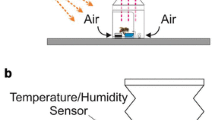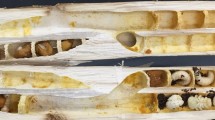Summary
Thorax surface temperature,T ts, was measured by a thermistor glued to the scutum, and inner thorax temperature,T ti, by a very fine thermoelement implanted in the scutellum (Fig. 1A, B). After implantation, exhaustion-flight experiments were made using an open jet wind tunnel (Fig. 1C) and previously exhausted, tethered bees fed on known quantities of glucose solution. Flights lasted up to 3 h at a wind velocity of 4.3 m s−1 and at ambient temperatures,T a, of 20, 25, 30 and 35°C.
T ti was significantly (1–1.5°C) higher thanT ts at all values ofT a (Fig. 2A-C). Temperature differences ΔT ts=T ts−T a, and ΔT ti=T ti−T a, were constant for approximately 75% of flight time, usually diminishing in the final 25% (Fig. 2). Mean ΔT ti was 1.12±0.48°C atT a=20°C, and 1.94±0.59°C at 25°C≤T a≤35°C (Fig. 3B). Regurgitation of liquid droplets did not reduceT ti orT ts. During flight,T ti,T ts and wingbeat frequency,F w, followed similar courses.
After exhaustion-flights mean body mass,M b, was 77.5±5.49 mg, independent ofT a (Fig. 3A). Wingbeat frequency was 144.8±13.5 s−1 atT a=20°C, and 167.6±10.1 s−1 at 25°C≤T a≤35°C (differences significant; Fig. 3C). Mean flight time after feeding with 10 μl glucose solution (1.54 mol glucose l−1) was 43.2±4.8 min atT a=20°C, and 30.6±4.7 min at 25°C≤T a≤35°C (differences significant; Fig. 3D). Under the same flight conditions, metabolic power,P m, was 17.29±1.94 mW atT a=20°C, and 24.69±3.60 mW at 25°C≤T a≤35°C (differences significant). Mean thermal conductivity was 0.63±0.26 W m−2 °C−1, independent ofT a (Fig. 2E).
AtT a=20°C, ΔT ti was proportional to wing stroke frequency,F w, (Fig. 4A);P m was porportional toF 1.73w (Fig. 4B). The exponent 1.73 is not significantly different (α=0.05) from 2.0. No correlation was found betweenP m andM b (Fig. 4C). Relative metabolic powerP mrel=P m M −1b was proportional toM −1.48b (Fig.4D).
Similar content being viewed by others
References
Bastian J, Esch H (1970) The nervous control of the indirect flight muscles of the honey bee. Z Vergl Physiol 67:307–324
Beutler R (1937) Über den Blutzucker der Bienen. Z Vergl Physiol 24:71–115
Bräuninger HD (1964) Über den Einfluß meteorologischer Faktoren auf die Entfernungsweisung im Tanz der Bienen. Z Vergl Physiol 48:1–130
Cahill K, Lustick S (1976) Oxygen consumption and thermoregulation inApis mellifera workers and drones. Comp Biochem Physiol 55A:355–357
Casey TM (1976a) Flight energetics of sphinx moth: power input during hovering flight. J Exp Biol 64:529–543
Casey TM (1976b) Flight energetics of sphinx moth: heat production and heat loss inHyles lineata during free flight. J Exp Biol 64:545–560
Casey TM (1980) Flight energetics and heat exchange of gypsy moths in relation to air temperature. J Exp Biol 88:133–145
Casey TM (1981) Insect flight energetics. In: Herreid CF, Fourtner CR (eds) Locomotion and energetics in Arthropods. Plenum Press, New York, pp 419–452
Casey TM, May ML (1982) Morphometrics, wingstroke frequency and energy metabolism of Euglossine Bees during hovering flight. In: Nachtigall W (ed) BIONA-report 1. Akad Wiss Mainz, G Fischer, Stuttgart, New York, pp 1–10
Chappell M (1982) Temperature regulation of carpenter bees (Xylocopa californica) foraging in the Colorado desert of Southern California. Physol Zool 55:267–280
Chappell M (1984) Thermoregulation of the green fig beetle (Cotinus texana) during flight and foraging behaviour. Physiol Zool 57:581–589
Esch H (1960) Über die Körpertemperaturen und den Wärmehaushalt vonApis mellifica. Z Vergl Physiol 43:305–335
Esch H (1976) Body temperature and flight performance of honey bees in a servomechanically controlled wind tunnel. J Comp Physiol 109:265–277
Esch H, Nachtigall W, Kogge SN (1975) Correlations between aerodynamic output, electrical activity in the indirect flight muscles and wind positions of bees in a servomechanically controlled wind tunnel. J Comp Physiol 100:147–159
Free JB, Spencer-Booth Y (1958) Observations on the temperature regulation and food consumption of honeybees (Apis mellifera). J Exp Biol 35:930–937
Frisch K von (1948) Gelöste und ungelöste Rätsel der Bienensprache. Naturwissenschaften 35:12–23
Frisch K von, Kratky O (1962) Über die Beziehung zwischen Flugweite und Tanztempo bei der Entfernungsmeldung der Bienen. Naturwissenschaften 49:409–417
Heinrich B (1972) Energetics and temperature regulation and foraging in a bumblebee,Bombus terricola Kirby. J Comp Physiol 77:49–64
Heinrich B (1979) Keeping a cool head: honeybee thermoregulation. Science 205:1269–1271
Heinrich B (1980a) Mechanisms of body-temperature regulation in honeybees,Apis mellifera. I. Regulation of head temperature. J Exp Biol 85:61–72
Heinrich B (1980b) Mechanisms of body-temperature regulation in honeybees,Apis mellifera. II. regulation of thoracic temperature at high air temperatures. J Exp Biol 85:73–87
Heran H (1956) Ein Beitrag zur Frage nach der Wahrnehmungsgrundlage der Entfernungsweisung der Bienen (Apis mellifica L.). Z Vergl Physiol 38:168–218
Heran H, Wanke L (1952) Beobachtungen über die Entfernungsmeldung der Sammelbienen. Z Vergl Physiol 34:383–393
Hocking B (1953) The intrinsic range and speed of flight of insects. Trans R Entomol Soc Lond 104:223–345
Jungmann R (1984) Stoffwechselphysiologische Untersuchungen an in einem Miniaturwindkanal fliegenden Honigbienen (Apis mellifica). Diplomarbeit, Universität des Saarlandes, unpublished
Jungmann R, Rothe U, Nachtigall W (1989) Flight of the honey bee. I. Thorax surface temperature and thermoregulation during tethered flight. J Comp Physiol B 158:711–718
Kammer AE, Heinrich B (1978) Insect flight metabolism. Adv Ins Physiol 13:133–228
Kosmin NP, Alpatow WW, Resnitschenko MS (1932) Zur Kenntnis des Gaswechsels und des Energieverbrauchs bei der Biene in Beziehung zu deren Aktivität. Z Vergl Physiol 17:408–422
Lindauer M (1954) Temperaturregulation und Wasserhaushalt im Bienenstaat. Z Vergl Physiol 36:391–432
Nachtigall W (1966) Die Kinematik der Schlagflügelbewegungen von Dipteren. Methodische und analytische Grundlagen zur Biophysik des Insektenflugs. Z Vergl Physiol 52:155–211
Nachtigall W, Rothe U, Feller P, Jungmann R (1989) Flight of the honey bee. III. Flight metabolic power calculated from gas analysis, thermoregulation and fuel consumption. J Comp Physiol B 158:729–737
Nicolson SW, Louw GN (1982) Simultaneous measurement of evaporative water loss, oxygen consumption, and thoracic temperature during flight in a carpenter bee. J Exp Zool 222:287–296
Parhon M (1909) Les échanges nutritifs chez les abeilles pendant les quatres saisons. Ann Soc Nat Zool 9:1–50
Rothe U (1983) Stoffwechselphysiologische Untersuchungen an ruhenden, laufenden und fliegenden Honigbienen (Apis mellifica carnica). Dissertation, Universität des Saarlandes, unpublished
Rothe U, Nachtigall W (1980) Zur Haltung vonApis mellifica in einem Flugraum. Apidologie 11:17–24
Rothe U, Nachtigall W (1982) Erfahrungen mit einem Bienenflugraum. Spontane Königinnenaufzucht und Lebensdaueranalysen. Apidologie 13:241–246
Rothe U, Nachtigall W (1989) Flight of the honey bee. IV. Respiratory quotients and metabolic rates during sitting, walking and flying. J Comp Physiol B 158:739–749
Sachs L (1984) Angewandte Statistik, 6. Aufl. Springer, Berlin Heidelberg New York
Schneider P (1980) Beiträge zur Flugbiologie der Käfer. 4. Körpertemperatur, Flugverhalten und Flügelschlagfrequenz. Zool Anz 205:1–19
Snodgrass RE (1956) Anatomy of the honey bee. Comstock Published Associates. Ithaca, NY
Sotavalta O (1952) The essential factor regulating the wingstroke frequency of insects in wing mutilation and loading experiments at subatmospheric pressure. Ann Zool “Vanamo” 15:1–67
Sotavalta O (1954a) On the fuel consumption of the honeybee (Apis mellifica L.) in flight experiments. Ann Zool “Vanamo” 16:1–27
Sotavalta O (1954b) On the thoracic temperature of insects in flight. Ann Zool Soc “Vanamo” 16:1–21
Werner G (1954) Tänze und Zeitempfinden der Honigbiene in Abhängigkeit vom Stoffwechsel. Z Vergl Physiol 36:464–487
Author information
Authors and Affiliations
Rights and permissions
About this article
Cite this article
Feller, P., Nachtigall, W. Flight of the honey bee. J Comp Physiol B 158, 719–727 (1989). https://doi.org/10.1007/BF00693010
Accepted:
Issue Date:
DOI: https://doi.org/10.1007/BF00693010




